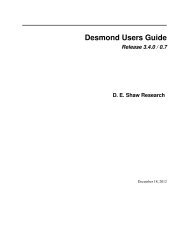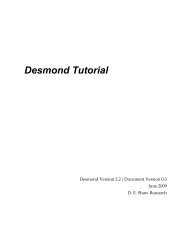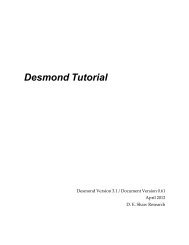Desmond Tutorial
Desmond Tutorial - DE Shaw Research
Desmond Tutorial - DE Shaw Research
- No tags were found...
You also want an ePaper? Increase the reach of your titles
YUMPU automatically turns print PDFs into web optimized ePapers that Google loves.
<strong>Desmond</strong> <strong>Tutorial</strong><br />
Preparing a <strong>Desmond</strong> simulation with the System Builder<br />
NOTE<br />
NOTE<br />
button to position the entry according to the saved transformation matrix. This way, all<br />
proteins will be placed in the membrane in exactly the same position and orientation.<br />
8. Finally, click the green Start button to start the membrane system setup. For 1su4, the<br />
setup procedure should take 6–8 minutes. The resulting simulation system is shown<br />
in Figure 4.14 on page 55. For better visualization, the protein is shown as a CPK<br />
model and the lipid bilayer is highlighted in green.<br />
The visible gap at the top and bottom of the lipid layer is the gap between the water<br />
layer that is part of the DPPC model and the extra water layer, which was added to the<br />
system to satisfy the boundary conditions. This is expected since the system is put<br />
together from two different, pre‐equilibrated boxes of a solvated lipid bilayer and plain<br />
solvent, respectively. The gap should go away after a relatively short equilibration<br />
period. However, membrane systems should be equilibrated for an extended period of<br />
time (up to a few hundred ns) to resolve the large hole that was carved out of the lipid<br />
bilayer to accommodate the transmembrane part of the protein. The hole is shown for<br />
the 1su4 structure in Figure 4.15.<br />
The protein in the simulation box in Figure 4.14 is positioned so that the head of the protein<br />
seems to protrude into vacuum. This is the result of a visual artifact discussed in<br />
“Defining the Simulation Box” on page 44. System Builder puts the center of gravity of<br />
the solute at the center of the simulation box. As a consequence, fairly non‐spherical systems<br />
will appear to shift toward one side of the simulation box. Membrane systems are<br />
extreme cases resulting in the view on Figure 4.14. This may not be ideal from a visual<br />
perspective, but in terms of periodic boundary conditions, this is perfectly adequate. It is<br />
a periodic image of the protruding part of the protein at the bottom of the simulation<br />
box where there is plenty of water, that is used in the computation (see Figure 4.14).<br />
54 D. E. Shaw Research September 2008






